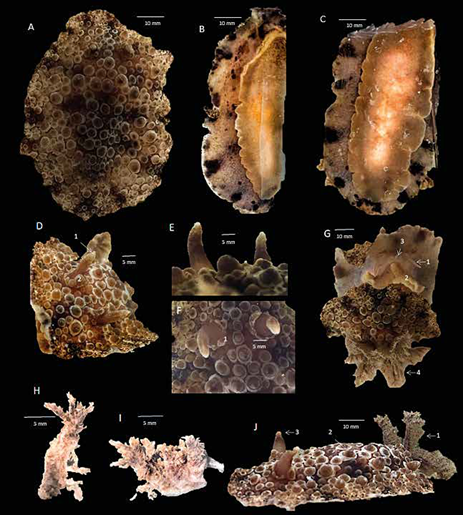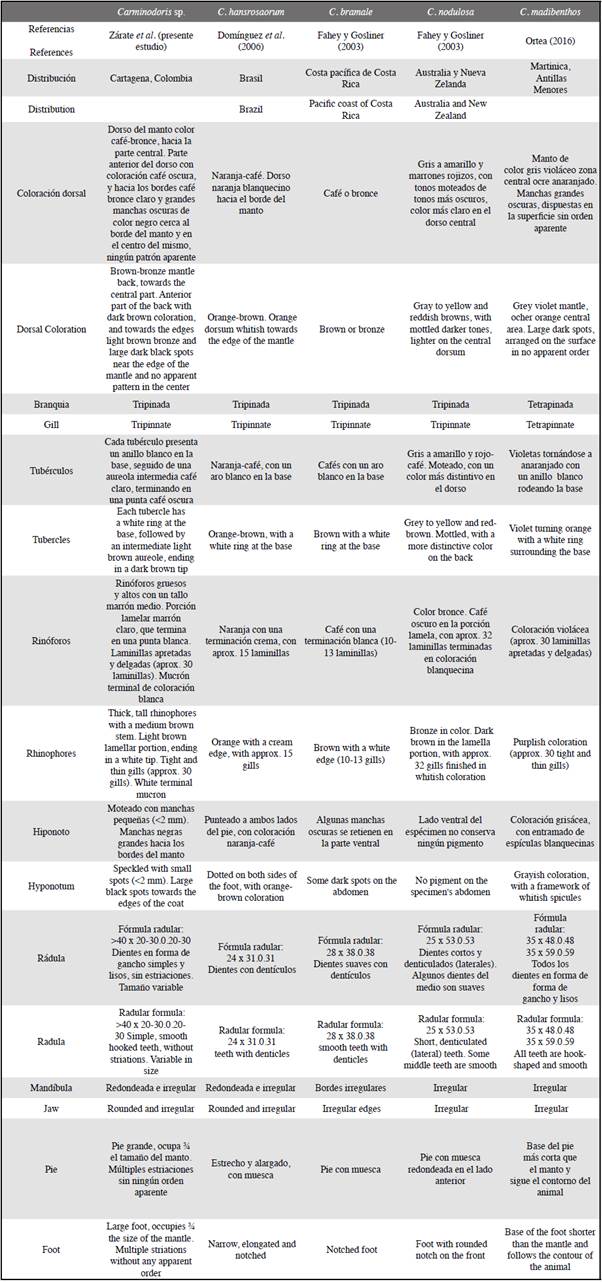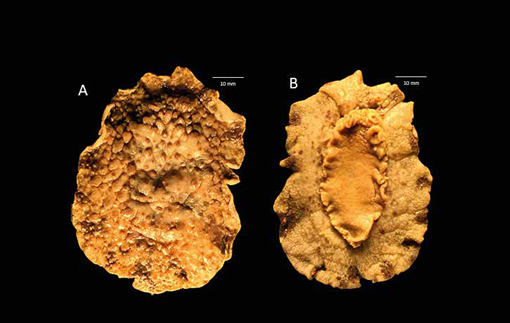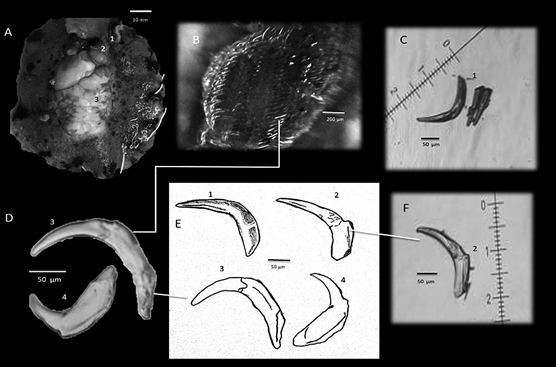Services on Demand
Journal
Article
Indicators
-
 Cited by SciELO
Cited by SciELO -
 Access statistics
Access statistics
Related links
-
 Cited by Google
Cited by Google -
 Similars in
SciELO
Similars in
SciELO -
 Similars in Google
Similars in Google
Share
Boletín de Investigaciones Marinas y Costeras - INVEMAR
Print version ISSN 0122-9761
Bol. Invest. Mar. Cost. vol.48 no.2 Santa Marta July/Dec. 2019 Epub Dec 13, 2019
https://doi.org/10.25268/bimc.invemar.2019.48.2.765
Research Articles
First record of the genus Carminodoris Bergh, 1889 (Gastropoda: Opisthobranchia: Nudibranchia: Doridoidea: Discodorididae) in the Colombian Caribbean
1 Centro de Investigación, Educación y Recreación- CEINER, Cartagena, Colombia z.juancamilo@yahoo.edu.co.
2 Universidad Jorge Tadeo Lozano, Sede Santa Marta, El Rodadero, Santa Marta, Colombia. shanlyc.coneog@utadeo.edu.co.
3 Universidad Jorge Tadeo Lozano, Facultad de Ciencias Naturales e Ingeniería, Departamento de Ciencias Biológicas y Ambientales, Bogotá, Colombia. monica.puyana@utadeo.edu.co.
In the Atlantic Ocean there are only two records of Nudibranchs belonging to the genus Carminodoris Bergh, 1889 (Discodorididae). This work describes and illustrates the first record of a Nudibranchs belonging to this genus in the Colombian Caribbean, in a sample collected on Isla San Martín de Pajarales, islas del Rosario, Cartagena, Colombia. The morphological and anatomical attributes of the studied specimen were compared with those reported for the Atlantic (Carminodoris hansrosaorum and C. madibenthos), and for the Pacific (C. nodulosa, C. grandiflora, C. bramale, C. flammea, C. bifurcata, C. armata and C. estrelyado). The studied sample differs from the other species by its size (74 mm), and distinctive morphological patterns (foot, tubercles, branchial plume, mantle, jaw and radular formula). This is the first report of this genus in the southwestern Caribbean and it might be a new species, yet to be confirmed, with additional anatomical and molecular studies.
KEY WORDS: Nudibranch; Discodorididae; Carminodoris; Rosario Islands; Caribbean; Colombia
En el océano Atlántico existen solo dos registros de especies de nudibranquios pertenecientes al género Carminodoris Bergh, 1889 (Discodorididae). En el presente trabajo se describe e ilustra el primer registro del género para el Caribe colombiano, a partir de un ejemplar recolectado en la isla San Martín de Pajarales, islas del Rosario, Cartagena, Colombia. Los atributos morfológicos y anatómicos del ejemplar estudiado se compararon con aquellos de las dos especies registradas para el Atlántico (Carminodoris hansrosaorum y C. madibenthos), y aquellas citadas para el Pacífico (C. nodulosa, C. grandiflora, C. bramale, C. flammea, C. bifurcata, C. armata y C. estrelyado). El ejemplar estudiado difiere de las otras especies descritas por su tamaño (74 mm), patrones morfológicos distintivos (pie, rinóforos, tubérculos, penacho branquial, manto, mandíbula) y fórmula radular. Este es el primer registro del género para el Caribe suroccidental y podría tratarse de una nueva especie, lo cual tendría que corroborarse con mayores estudios anatómicos y moleculares.
PALABRAS CLAVE: Nudibranquios; Discodorididae; Carminodoris; Islas del Rosario; Caribe
INTRODUCTION
Nudibranchs (Mollusca: Gastropoda: Opisthobranchia) are mollusks with a variety of shapes and include organisms with or without shells (Gosliner, 1994). In Colombia, only eight nudibranchs species have been recorded that belong to the Discodoridae family, two species to the Discodoris genus, one representative for the Peltodoris, Diaulula, Taringa, Thordisa and one for the Joruna genus that has yet to be confirmed (Ardila et al., 2007). The genus Carminodoris (formerly known as Hoplodoris Bergh, 1880) also belongs to this family (Cervera et al., 2004; Dayrat, 2010), where fifteen species were recognized up until 2016 and one whose status has not yet been confirmed (WoRMS Editorial Board, 2019).
The description of the genera Hoplodoris and Carminodoris has been qualified as problematic by different authors (Miller, 1991; Gosliner and Behrens, 1998; IZCN), and the lack of clarity in the descriptions means that their taxonomic status changes constantly. Fahey and Gosliner (2003) agree that the confusion is due to the little information in the original descriptions proposed by Bergh (1880 and 1889), such as external morphological characters and coloring patterns of living organisms. In addition to this, the lack of specimens and some details of the female reproductive system in the case of Carminodoris and sperm storage organs in the case of Hoplodoris, corroborate the absence of information for both genera. Despite this, the genus Hoplodoris is not accepted and currently all its species have been transferred to the genus Carminodoris, with the exception of one that changed to the genus Asteronotus (Dayrat, 2010; WoRMS Editorial Board, 2019).
Carminodoris is characterized by simple, long and rounded tubercles on the back surface of the mantle, a head with two conical oral tentacles, radula composed of simple teeth and hermaphroditism with a flat reproductive system and two well differentiated regions (Valdés, 2002). Domínguez et al. (2006) described a new species (C. hansrosaorum) from a 27 mm specimen collected in Cabo Frio Island, Rio de Janeiro, Brazil, constituting the first record of the genus for the Atlantic Ocean. The species was described based on morphology, anatomy of internal organs and aspects of the radula. Subsequently, Ortea (2016) described a second species of this genus for the western Atlantic (C. madibenthos) from a 50 mm specimen found on the island of Martinique, Lesser Antilles. It was identified based on morphological aspects, reproductive structures and characteristics of the radula.
So far there are no records of the genus Carminodoris for the Pacific or the Colombian Caribbean. This paper is the first record of the genus for the Colombian Caribbean and the third for the Atlantic Ocean. As such, we describe the first specimen of the genus Carminodoris collected on Isla San Martín de Pajarales, Islas del Rosario, Cartagena, Colombia.
MATERIALS AND METHODS
The mollusk was found alive inside a marine fish-breeding tank (maximum water capacity 100 m3 and depth 2.5 m) in the oceanarium at Islas del Rosario, on January 31, 2018, during cleanup work. The tanks have several direct water intakes from the area adjacent to the oceanarium, providing refuge for various organisms such as fish, mollusks and crustaceans.
The specimen collected alive was introduced into a marine aquarium in the CEINER (Centro de Investigación, Educación y Recreación, San Martín de Pajarales, Islas del Rosario) laboratory for macroscopic description, subsequent identification, and photographic record. Subsequently, the specimen was preserved in 70% ethanol for dissection and internal anatomy analysis. The macroscopic and microscopic structures (rhinophores, radula, branchial plume, internal organs, among others) were observed using a stereoscope (Carl Zeiss. Serial 2004010114) and a microscope (Carl Zeiss. Serial 3108002222). The photographs were taken using an Iphone 5s.
RESULTS
Order: Nudibranchia
Family: Discodorididae Bergh, 1891
Genus: Carminodoris Bergh, 1889
Carminodoris sp.
Examined material: A specimen collected alive in a marine fish-breeding tank in the oceanarium at Isla San Martín de Pajarales, Islas del Rosario, Parque Nacional Natural Corales del Rosario y San Bernardo, Cartagena, Colombia. Collected by C. Zárate, on January 31, 2018. The live specimen recorded a length of 74 mm and a maximum width of 58 mm (Figure 1 A). Once preserved, the mollusk contracted and its dimensions changed to 57 mm long and 42 mm wide (Figure 2 A-B).

Figure 1 Carminodoris sp. A. Dorsal view and B and C. Ventral view of the live specimen: 1. 2. Striation of the foot. D-F. Rhinophores: D. 1. Terminal mucron; 2. E. Rhinophores. F. 1. Rhinophore sheath. G. Living organism: 1. Digitiform tentacles. 2. Bilabiated anterior rim. 3. Nerve ganglion. 4. Branchial plume. H and I. Branchial plume leaflets. J. Living organism. 1. Branchial plume. 2. Tubercles. 3. Rhinophores.
Description: External morphology (Figure 1): The specimen's body is oval and flat, the back of the mantle is brown-bronze towards the central part; the anterior part of the mantle is dark brown and light brown-bronze towards the edges. The mantle has large dark spots near the edge and in the center, without an apparent pattern (Figure 1 A-C). The entire notum of the specimen, except for the area immediately around the rhinophores, is covered by more or less rounded tubercles of variable size, with those in the central dorsal portion being larger (Figure 1A). Along the edge of the mantle, the tubercles diminish and join in a compact fashion. Most tubercles have a white ring at the base, followed by an intermediate light brown aureole, ending in a dark brown tip at the end of each (Figure 1 J). The branchial plume is divided into six dark brown, feathery tripinnate gill leaves. The front and back of the plume are light brown (Figures 1 G4, H, I y J1).
The rhinophore sheath (Figures 1D2 and 1F1) and the gill sheath are low and irregular, with small rounded tubercles except for the inner part. Thick, tall rhinophores with a brown base and a light brown lamellar portion, with a series of tight, thin gills (approximately 30) (Figure 1D-F and 1J3) and a white terminal mucron (Figure 1D1).
On the abdomen, the hyponotum is light brown with small black dots (< 2 mm), which give it a mottled appearance (Figure 1B). The ventral edge of the mantle also bears large black spots as does the back, without an apparent pattern (Figure 1 B-C). The base of the foot is yellow-brown, bilabiated near the front edge (Figure 1 B, C and G2). Two digitiform tentacles are observed on the head (Figure 1G1). The foot of the animal is large, close to three quarters of the length of the mantle, with multiple striations, in no apparent order (Figure 1C). Its shape follows the oval contour of the organism. The specimen conserved in 70% ethanol acquired a uniform yellow-brown color, dorsally and ventrally (Figure 2A). The foot contracted following the shape of the striations (Figure 2B).
Internal morphology: The mouth is at the top of the ventral view, located above the salivary gland and nerve ganglion (Figure 3A). Bulging digestive gland. Large amount of yellow gastrointestinal muscle (Figure 3A3). The organism's jaw is rounded and irregular. The radula was found to be oppressed and irregular in a circular fashion (Figure), with which it was possible to generate an approximate radular formula: >40 x 20-30.0.20-30. All teeth are smooth and hook shaped (Figure 3E). The size of the teeth increases progressively along each row. The first third of teeth are hook-shaped, long and thin towards the base (Figure 3D3 and 3E3). The second third has a long, smooth hook and a thick base (Figure 3C, 3F, 3E1 and 3E2). In the third third they decrease in size regularly and progressively with a short, smooth hook and a thick-robust base (Figure 3D4 and 3E4). The genital openings are located on the right anterior flank, near the head.
DISCUSSION
According to Valdés (2002), the genus Carminodoris has several key characteristics: the dorsal portion of the mantle is covered by large simple and rounded tubercles; its head has two cone-shaped oral tentacles; a bifurcated, grooved and notched forefoot rim; labial armor with mandibular elements; radula composed of bone-cultured simple regular teeth. The specimen studied differs from the other species described in the genus because of its size. All the species described have been recorded as being in a length range of 20 to 54 mm (Table 1), while the specimen collected had a total length of 74 mm. The specimen described here is phenotypically similar to C. hansrosaorum (Domínguez et al., 2006; Alvim and Pimenta, 2013) and C. madibenthos (Ortea, 2016) from the Atlantic Ocean, as well as C. nodulosa (Fahey and Gosliner, 2003), C. bramale (Fahey and Gosliner, 2003) and C. grandiflora (Fahey and Gosliner, 2003) from the Pacific Ocean (Table 1). The mantle of most such species is brown and has a series of tubercles surrounded by a white ring at the base. However, the specimen described here has a different coloration pattern towards the anterior-central part of the dorsum, where it takes on a dark brown-black coloration and a light brown-bronze towards the edges. It has large spots towards the edge of the mantle, differentiating it from most such species, as in the others, when they are present; they tend to be tenuous or, as in the case of C. grandiflora, located in the center of the mantle. Similarly, the specimen shows a marked differential pattern from the other species in the hyponotum. When compared with C. hansrosaorum, it is similar in the mottled scheme towards the central zone, but differs by the large black spots marked on the ventral edge. Similarly, C. madibenthos and C. bramale differ in this part, as they only have some pale spots, and the central ventral fraction is not mottled (Ortea, 2016; Fahey and Gosliner, 2003). In other cases such as C. nodulosa, the ventral portion has no pigment (Domínguez et al., 2006).
The rhinophores of Carminodoris sp. are different from those of the other species already described for their coloring. The rhinophores of C. nodulosa and C. madibenthos have 32 and 30 gills, respectively (Table 1), as found in the specimen studied. However, the rhinophores of C. madibenthos have a violet grey coloration and do not have a terminal mucron (Ortea, 2016). The branchial plume of the specimen studied differs only from that of C. madibenthos, which is tetrapinnate (Ortea, 2016).
Table 1 Diagnostic characters in nudibranch species of the genus Carminodoris (taken and modified from Domínguez et al., 2006)

The foot of the specimen is very different to the specimens of Carminodoris registered for the Atlantic, because it is quite wide and with multiple striations. The foot of C. madibenthos is moderately wide, with few striations, while that of C. hansrosaorum is narrow.
Internally, the specimen under study is close in its radular formula to C. armata (45 x 50-60.0.50-60; Pacific species) and C. grandiflora (26-40 x 40-116.0.40-116; Pacific species, Madagascar) (Table 1). This feature is key in differentiating it from the other species in both genera, because the number of rows of teeth varies between 24 and 38 and the approximate number of teeth for this specimen is greater than 40. Similarly, C. armata, C. hansrosaorum, C. bramale and C. madibenthos have teeth with denticles and the specimen under study has smooth and hooked teeth. This is a distinctive feature when compared to C. hansrosaorum (Ortea, 2016), which is shared with C. madibenthos, differing in the second and third third of the teeth, which have a smooth hook and a thick-robust base (distinctive feature when compared to C. madibenthos).
Species such as C. grandiflora (Fahey and Gosliner, 2003), C. bifurcata (Fahey and Gosliner, 2003), C. nodulosa (Fahey and Gosliner, 2003), C. bramale (Fahey and Gosliner, 2003), C. bifurcata (Fahey and Gosliner, 2003).
C. estrelyado (Gosliner and Behrens, 1998), C. flammea (Fahey and Gosliner, 2003) and C. armata (Baba, 1993), are species whose distribution has been mentioned for the Pacific and Indian Oceans. Regarding the geographical distribution in the Atlantic, Carminodoris sp. is the first record of the genus for Colombia and the third for the Atlantic. This is why it is presumed that it could be a new species for the Caribbean; more specimens and molecular studies are needed to corroborate its identity.
ACKNOWLEDGEMENT
The authors thank the Centro de Investigación, Educación y Recreación- CEINER and the Parque Nacional Natural Corales del Rosario y San Bernardo-PNNCRSB. They also thank Rafael Vieira, Jaime Rojas, Robin de la Rosa, and Ángel Valdés (California State Polytechnic University) for their comments and assessment of the specimen under study.
REFERENCES
Alvim J. and A. D. Pimenta. 2013. Taxonomic review of the family Discodorididae (Mollusca: Gastropoda: Nudibranchia) from Brazil, with descriptions of two new species. Zootaxa, 3745(2): 152-198. [ Links ]
Ardila, N. E., D. Báez y Á. Valdés. 2007. Babosas y liebres de mar (Mollusca: Gastropoda: Opisthobranchia) de Colombia. Biota Col., 8(2): 185-197. [ Links ]
Cervera, J.L., G. Calado, C. Gavaia, M.A.E. Malaquias, J. Templado, M. Ballesteros, M. and C. Megina. 2004. An annotated and updated checklist of the opisthobranchs (Mollusca: Gastropoda) from Spain and Portugal (including islands and archipelagos). Bol. Inst. Esp. Oceanogr., 20(1-4): 1-122. [ Links ]
Dayrat, B. 2010. A monographic revision of basal discodorid sea slugs (Gastropoda, Opisthobranchia, Nudibranchia, Doridina). Proc. Calif. Acad. Sci. Series 4, suppl. I, 61: 1-403, 382. [ Links ]
Díaz, J., J. Pinzón, J. Garzón-Ferreira, L. Boulon, M. López, M. Cendales, F. Velandia, F. Zapata, G. Ospina, B. Vargas y S. Zea. 2000. Áreas coralinas de Colombia. Ser. Publ. Esp. Invemar, 5: 31-45. [ Links ]
Domínguez, M., F. García and J. Troncoso. 2006. A new species of Hoplodoris Bergh, 1880 (Gastropoda: Opisthobranchia: Nudibranchia) from the Atlantic Ocean. The Nautilus, 120(4): 150-155. [ Links ]
Fahey, S. and T. M. Gosliner. 2003. Mistaken identities: On the Discodorididae genera Hoplodoris Bergh, 1880 and Carminodoris Bergh, 1889 (Opisthobranchia, Nudibranchia). Proc. Calif. Acad. Sci., 54(10): 169-208. [ Links ]
Flores-Rodríguez, P., R. Flores-Garza, S. García-Ibáñez, A. Valdés-González, B.G. Martínez-Vásquez, Y. Mora-Marín y E. J. González-Sandoval. 2017. Riqueza, composición de la comunidad y similitud de las especies bentónicas de la subclase Opisthobranchia (Mollusca: Gastropoda) en cinco sitios del litoral de Acapulco, México. Rev. Biol. Mar. Oceanogr., 54(1): 67-80. [ Links ]
Gosliner, T. 1994. Gastropoda: Opisthobranchia. 253-355. In: Harrison, F. and A. Kohn. (Eds.). Microscopic anatomy of invertebrates. New York. 498 p. [ Links ]
Gosliner, T. M. and D. W. Behrens. 1998. Two new discodorid nudibranchs from the Western Pacific with a redescription of Doris luteola Kelaart, 1858. Proc. Calif. Acad. Sci. serie 4, 50(11): 279-293. [ Links ]
Miller, M. 1991. On the identity of the dorid nudibranch Homoiodoris novaezelandiae Bergh, 1904 (Gastropoda: Opisthobranchia). J. Nat. Hist., 25 (2): 293-304. [ Links ]
Ortea, J. 2016. Una segunda especie atlántica del género Hoplodoris Bergh, 1880 (Mollusca: Nudibranchia) colectada en Martinica, Antillas Menores. Rev. Acad. Canar. Cienc., 28: 201-208. [ Links ]
Valdés, A. 2002. A phylogenetic analysis and systematic revision of the cryptobranch dorids (Mollusca, Nudibranchia, Anthobranchia). Zool. J. Linnean Soc., 36: 535-636. [ Links ]
WoRMS Editorial Board, 2019. World register of marine species. Available from Available from http://www.marinespecies.org at VLIZ. Accessed 2019-05-15. doi:10.14284/170. [ Links ]
Received: February 05, 2019; Accepted: July 03, 2019











 text in
text in 





